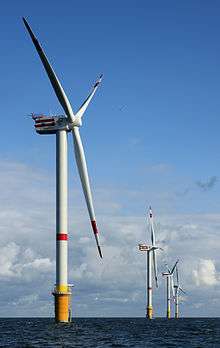Wet oxidation
Wet oxidation is a form of hydrothermal treatment. It is the oxidation of dissolved or suspended components in water using oxygen as the oxidizer. It is referred to as "Wet Air Oxidation" (WAO) when air is used. The oxidation reactions occur in superheated water at a temperature above the normal boiling point of water (100 °C), but below the critical point (374 °C).
The system must be maintained under pressure to avoid excessive evaporation of water. This is done to control energy consumption due to the latent heat of vaporization. It is also done because liquid water is necessary for most of the oxidation reactions to occur. Compounds oxidize under wet oxidation conditions that would not oxidize under dry conditions at the same temperature and pressure.
Commercial applications
Wet oxidation has been used commercially for around 60 years. It is used predominantly for treating wastewater. It is often referred to as Zimpro (from ZIMmerman PROcess), after Fred T. Zimmermann who commercialized it in the mid 20th century.[1]
Commercial systems typically use a bubble column reactor, where air is bubbled through a vertical column that is liquid full of the hot and pressurized wastewater. Fresh wastewater enters the bottom of the column and oxidized wastewater exits the top. The heat released during the oxidation is used to maintain the operating temperature.
The majority of commercial wet oxidation systems are used to treat industrial wastewater, such as sulfide laden spent caustic streams. Almost as many systems are also used for treating biosolids, in order to pasteurize and to decrease volume of material for disposal.
A special type of wet oxidation process was the so-called "VerTech process" system. A system of this type operated in Apeldoorn, Netherlands between 1994 and 2004. The system was installed in a below-ground pressure vessel (also called a gravity pressure vessel or GPV). The pressure was supplied by feeding the material to a reactor with a depth of 1,200 metres (3,900 ft). The deep shaft reactor also served as a heat exchanger, so no pre-heating was required. The operating temperature was about 270 °C with a pressure of about 100 bars (1,500 psi). The installation was eventually shut down due to operational problems.
See also
References
- Zimmermann, F. Waste Disposal, US Patent 2665249, 1950.
- Mishra, V.; Mahajani, V.; Joshi, J. "Wet Air Oxidation", Ind. Eng. Chem. Res.", 34, 2-48, 1995.
- Maugans C.; Ellis, C. "Wet Air Oxidation: A Review of Commercial Sub-Critical Hydrothermal Treatment", Twenty First Annual International Conference on Incineration and Thermal Treatment Technologies, New Orleans, May 13-17, 2002. WAO History Paper
- Patria, L.; Maugans, C.; Ellis, C.; Belkhodja, M.; Cretenot, D.; Luck, F.; Copa, B. "Wet Air Oxidation Processes", Advanced Oxidation Processes for Water and Wastewater Treatment, S. Parsons Editor, pp 247–274. 2004, IWA Publishing.
- Giudici, D.; Maugans, C. "Improvement of Industrial Synthesis of Methyl Methacrylate Application of a Wet Air Oxidation Process (WAO)", MMA WAO Paper
- ↑ "Zimpro History". Retrieved February 2010. Check date values in:
|access-date=(help)| archiveurl=http://web.archive.org/web/20130331083844/http://www.water.siemens.com/en/about_us/legacy_brands/Pages/zimpro.aspx | archivedate=2013-03-31
